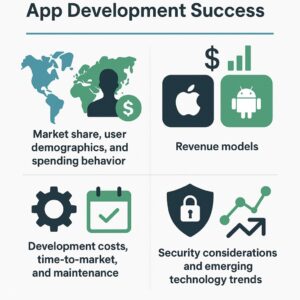In today’s digital era, mobile applications serve as powerful business tools, offering direct engagement with users and significant revenue opportunities. With the mobile app market projected to exceed $366 billion by 2027, choosing between iOS and Android for mobile app development services is a critical decision. Each platform has its advantages, but which one delivers greater profitability? Let’s examine the key factors.

Market share, user demographics, and spending behavior
Selecting the right platform starts with understanding your target audience. Market share distribution varies by region:
- North America & Western Europe: iOS dominates with over 50% market share, attracting high-income users who spend more on apps and in-app purchases.
- Asia & Africa: Android holds a strong majority, with over 80% market share in some regions, making it ideal for mass-market penetration.
- South America & Eastern Europe: Android leads in overall market share, but iOS captures a lucrative segment of high-value users.
Beyond regional trends, age and spending habits play a crucial role. iOS users tend to have higher disposable income and are more likely to pay for apps and subscriptions, whereas Android users favor free apps with ad-based monetization models.
Revenue models: which platform yields higher profits?
Monetization strategies differ significantly between iOS and Android:
Top Revenue Streams:
- Paid apps & subscriptions – iOS leads, with iPhone users spending nearly twice as much on apps and in-app purchases compared to Android users.
- Ad-based revenue – Android excels in this space due to its vast user base, making it ideal for free apps that generate revenue through ads.
While iOS offers a higher average revenue per user (ARPU), Android’s sheer market volume makes it competitive in total earnings. The ideal platform depends on whether you prioritize high-value transactions or broad audience reach.
Development costs, time-to-market, and maintenance
Cost efficiency and development speed are critical when launching a mobile app:
- Development complexity: Android development requires more time and resources due to device fragmentation. In contrast, iOS, with its limited device ecosystem, enables faster development and testing.
- App approval process: Apple’s rigorous app review process can delay time-to-market, whereas Google Play’s more lenient approval system allows for quicker releases.
- Maintenance & updates: Android apps require ongoing optimization for multiple devices and OS versions, while iOS apps generally have lower maintenance demands.
Security considerations and emerging technology trends
Security plays a pivotal role in mobile app strategy:
- iOS: Apple’s closed ecosystem and stringent app guidelines enhance security, reducing vulnerability to malware.
- Android: Open-source flexibility makes Android more susceptible to security risks, requiring additional cybersecurity measures.
Advancements in AI-driven personalization, augmented reality (AR), and blockchain are reshaping mobile app development services. While both platforms integrate emerging technologies, Apple’s ecosystem often leads in innovation, making it a prime choice for high-end app development.
Conclusion: making the right choice for maximum profitability
If your business strategy prioritizes premium users, higher spending, and brand loyalty, iOS is the superior choice. However, if your goal is broad market reach, ad revenue, and accessibility, Android is the better fit.
For optimal results, cross-platform development offers the best of both worlds. Partnering with expert mobile app development services ensures your app aligns with market demands while maximizing revenue potential.



